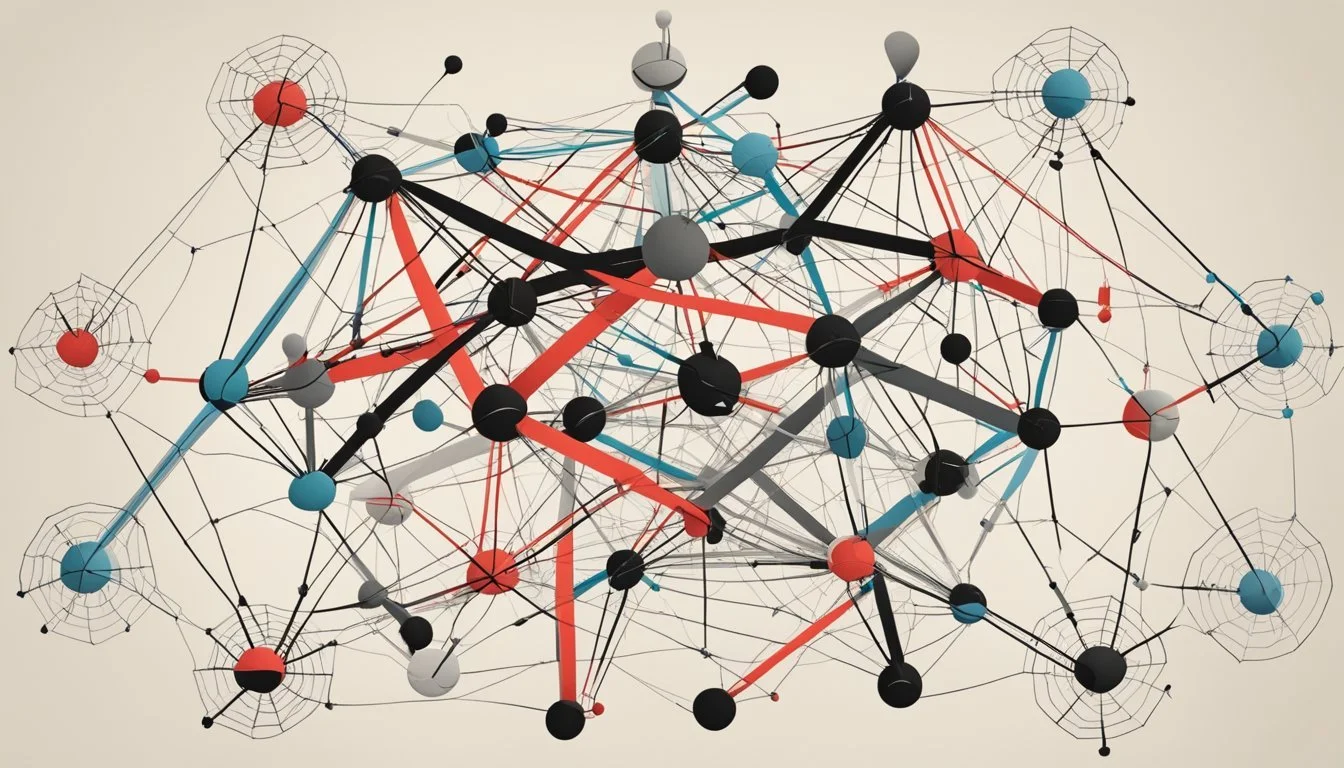Visualizing Toxic Relationship Patterns with Graphs
Toxic relationships follow a predictable pattern that can be visualized as a graph. This pattern typically includes three main stages: idealization, devaluation, and discard. Understanding this toxic relationship graph can help individuals recognize harmful patterns and make informed decisions about their relationships.
The idealization stage often starts with "love bombing," where one partner showers the other with excessive affection and praise. This creates an illusion of a perfect connection. As time progresses, the relationship moves into the devaluation phase. Here, criticism, manipulation, and emotional abuse become more frequent, eroding the victim's self-esteem.
The final stage, discard, occurs when the toxic partner loses interest or finds a new target. They may abruptly end the relationship or engage in behaviors that force their partner to leave. Recognizing these stages can empower individuals to break free from toxic cycles and prioritize their mental health and well-being.
Understanding Toxic Relationships
Toxic relationships are characterized by harmful patterns of behavior that negatively impact one or both partners. These dynamics can erode mental health, self-esteem, and overall well-being.
Defining a Toxic Relationship
A toxic relationship is one where partners engage in behaviors that are emotionally or physically damaging. These relationships often involve a power imbalance, with one partner exerting control over the other.
Key elements include:
Lack of mutual respect
Constant criticism and negativity
Manipulation and gaslighting
Absence of trust and support
Partners may experience feelings of anxiety, stress, and fear. The relationship becomes a source of pain rather than comfort and growth.
Signs of a Toxic Relationship
Recognizing toxic patterns is crucial for addressing relationship issues. Common signs include:
Constant criticism and belittling
Controlling behaviors
Lack of boundaries
Dishonesty and frequent lying
Jealousy and possessiveness
Persistent feelings of walking on eggshells
Partners may notice a decline in their self-esteem and confidence. They might feel drained, anxious, or depressed after interactions with their significant other.
Physical symptoms like headaches, digestive issues, or sleep problems may also manifest due to relationship stress.
Types of Abuse
Abuse in toxic relationships can take various forms:
Verbal Abuse: Yelling, name-calling, harsh criticism
Emotional Abuse: Manipulation, guilt-tripping, gaslighting
Physical Abuse: Hitting, pushing, or any form of physical violence
Sexual Abuse: Non-consensual sexual acts, coercion
Psychological Abuse: Threats, intimidation, isolation
These forms of abuse often overlap and can escalate over time. Victims may experience fear, guilt, and shame, making it difficult to seek help or leave the relationship.
It's important to note that abuse is never the victim's fault, and professional help should be sought for support and safety planning.
Dynamics of Toxic Relationships
Toxic relationships exhibit harmful patterns that negatively impact those involved. These dynamics often follow predictable cycles and involve specific traits and behaviors from abusers that cause significant harm to victims.
Patterns of Control and Manipulation
Toxic relationships frequently involve one partner exerting control over the other. This can manifest as:
Excessive jealousy and possessiveness
Isolating the victim from friends and family
Making all decisions without input
Monitoring the victim's activities and communications
Manipulative tactics are common, including:
• Gaslighting: Making the victim doubt their own perceptions • Guilt-tripping: Using shame to control behavior • Love bombing: Showering affection to later withdraw it
These patterns create an environment of distrust and insecurity for the victim.
Cycle of Abuse
The cycle of abuse in toxic relationships typically follows four stages:
Tension building: Stress increases, communication breaks down
Incident: Verbal, emotional, or physical abuse occurs
Reconciliation: Abuser apologizes, makes excuses, shifts blame
Calm: "Honeymoon" period before tensions rise again
This cycle repeats, often escalating over time. Victims may feel trapped, walking on eggshells to avoid triggering the next incident.
Traits of Abusers
Common traits of abusers in toxic relationships include:
Lack of empathy
Need for power and control
Manipulative behavior
Inability to take responsibility
Abusers often display a public façade that contrasts sharply with their private behavior. They may be charming to others while demeaning and disrespectful to their partner.
The Impact on Victims
Victims of toxic relationships often experience:
• Chronic stress and anxiety • Depression and low self-esteem • Physical health problems • Social isolation • Financial instability
Victims may blame themselves for the abuse, feeling guilty or ashamed. Fear of retaliation or uncertainty about the future can make it difficult to leave.
Long-term effects can include trust issues, PTSD, and difficulty forming healthy relationships. Recovery is possible with support, but the impact can persist long after the relationship ends.
Effects on Mental and Physical Health
Toxic relationships can have severe consequences for both mental and physical wellbeing. Prolonged exposure to unhealthy relationship dynamics often leads to a range of psychological and physiological issues.
Mental Health Consequences
Toxic relationships frequently result in depression, anxiety, and post-traumatic stress disorder (PTSD). Victims may experience low self-esteem, persistent feelings of worthlessness, and difficulty trusting others. Chronic stress from ongoing conflict or emotional manipulation can lead to mood swings and irritability.
Many individuals in toxic relationships report symptoms of anxiety, including constant worry, restlessness, and panic attacks. PTSD can develop, especially in cases involving abuse or severe emotional trauma. Flashbacks, nightmares, and hypervigilance are common symptoms.
Depression is another prevalent outcome. Feelings of hopelessness, loss of interest in activities, and changes in sleep or appetite patterns may occur. In severe cases, suicidal thoughts can emerge.
Physical Health Outcomes
The stress of toxic relationships can manifest in physical symptoms and health problems. Headaches, muscle tension, and gastrointestinal issues are frequently reported. Chronic stress may lead to a weakened immune system, making individuals more susceptible to illnesses.
Cardiovascular problems, including high blood pressure and increased risk of heart disease, can develop due to prolonged stress. Sleep disturbances are common, ranging from insomnia to excessive sleeping. This can further impact overall health and cognitive function.
Some individuals may turn to unhealthy coping mechanisms, such as substance abuse or disordered eating, which can have additional negative effects on physical health. Weight fluctuations, either gain or loss, are not uncommon.
Identifying and Setting Boundaries
Boundaries are essential for maintaining healthy relationships and protecting one's wellbeing. They define personal limits and expectations for behavior within relationships.
Recognizing Unhealthy Boundaries
Unhealthy boundaries often manifest through controlling or critical behavior. A partner may exhibit jealousy, monitor communications, or make decisions without consent.
They may disregard personal space or privacy, expecting constant access and emotional support. Criticism of values, appearance, or choices is common.
Red flags include:
Frequent guilt-tripping
Emotional manipulation
Disrespect for personal time or belongings
Violation of agreed-upon limits
Recognizing these signs is crucial for identifying toxic patterns in relationships.
How to Establish and Maintain Boundaries
Setting clear boundaries involves direct communication of needs and limits. Start by identifying personal values and non-negotiable aspects of life.
Express boundaries firmly but respectfully. Use "I" statements to convey feelings and expectations. For example: "I need time alone to recharge."
Be consistent in enforcing boundaries. Respond calmly but firmly to violations. Reiterate limits as needed.
Tips for maintaining boundaries:
Practice self-awareness
Regularly reassess personal needs
Seek support from trusted friends or professionals
Learn to say "no" without guilt
Remember, healthy boundaries foster mutual respect and create space for individual growth within relationships.
Support and Resources
Seeking help and building a support network are crucial steps for those in toxic relationships. Professional assistance and caring connections provide vital guidance and emotional backing.
Seeking Professional Help
Therapists offer specialized support for individuals in toxic relationships. They provide tools to recognize unhealthy patterns and develop coping strategies. Many therapists use evidence-based approaches like cognitive-behavioral therapy to address relationship issues.
The National Domestic Violence Hotline is a valuable resource for those experiencing abuse. Trained advocates offer confidential support 24/7. They can provide safety planning, crisis intervention, and referrals to local services.
Support groups bring together people with similar experiences. These groups foster understanding and reduce isolation. Participants can share strategies for healing and rebuilding self-esteem.
Building a Support Network
Trusted family members and friends play a key role in supporting those in toxic relationships. They can offer emotional support, practical assistance, and a safe space to discuss concerns.
Positive relationships with compassionate individuals help counteract the negative effects of toxic interactions. Encouraging friends uplift and validate the person's experiences and feelings.
Creating a diverse support network enhances resilience. This may include joining community organizations, faith groups, or hobby clubs. These connections provide opportunities for positive interactions and personal growth.
Online forums and support communities can supplement in-person networks. They offer anonymity and 24/7 access to understanding peers. However, it's important to verify the credibility of online resources and maintain privacy.
Moving Forward
Breaking free from a toxic relationship requires courage, self-reflection, and a commitment to personal growth. The journey involves careful planning, healing, and redefining one's understanding of love.
Planning to Leave the Relationship
Recognizing the need to leave a toxic relationship is the first step towards reclaiming one's well-being. Creating a safety plan is crucial, especially if physical or emotional abuse is present. This plan should include:
Secure housing arrangements
Financial resources
Support system contacts
Important documents and belongings
It's essential to establish boundaries and communicate intentions clearly. Seeking professional help, such as counseling or legal advice, can provide guidance and support during this challenging time.
Post-Breakup Recovery
After leaving a toxic relationship, focus on healing and self-care. This process involves:
Acknowledging emotions without judgment
Practicing self-compassion
Engaging in activities that promote well-being
Rebuilding self-esteem and confidence
Surrounding oneself with supportive friends and family can aid recovery. Consider joining support groups or seeking therapy to work through lingering emotional issues. Establish new routines and set personal goals to regain a sense of independence and purpose.
Creating a New Definition of Love
Redefining love after a toxic relationship is crucial for future happiness. This involves:
Identifying healthy relationship traits
Recognizing red flags and deal-breakers
Developing strong communication skills
Cultivating self-love and self-respect
Take time to reflect on personal values and desires in a partner. Learn to trust intuition and set clear boundaries. Practice vulnerability in safe environments to build emotional intelligence. Remember that healthy love is based on mutual respect, support, and growth.
Toxic Relationships in Different Contexts
Toxic relationships can manifest in various spheres of life, causing emotional distress and harmful interactions. These dynamics often involve patterns of control, manipulation, and abuse that negatively impact individuals' well-being.
Intimate Partner Violence
Intimate partner violence is a severe form of toxicity in romantic relationships. It encompasses physical, emotional, and psychological abuse. Abusers often isolate their partners from friends and family, cutting off support systems.
Controlling behaviors may include monitoring phone calls, restricting finances, or dictating clothing choices. Jealousy frequently fuels accusations and possessive actions. Victims often experience humiliation, threats, and coercion.
Gaslighting is a common tactic, where abusers deny or distort reality to make victims doubt their own perceptions. This manipulation can erode self-esteem and create dependency on the abuser.
Family and Friends
Toxic family relationships can involve emotional blackmail, guilt-tripping, and boundary violations. Parents may be overly critical or dismissive of their children's feelings and achievements.
Siblings might engage in constant competition or scapegoating. Extended family members may spread gossip or create drama at gatherings. These dynamics can lead to long-lasting emotional scars and trust issues.
Toxic friendships often feature one-sided giving, where one person consistently takes advantage of the other's generosity. Backstabbing, jealousy, and negative comments about appearance or accomplishments are common.
Friends who constantly criticize or belittle can damage self-esteem. Some may use emotional manipulation to maintain control over the relationship.
Workplace and Professional Relationships
Toxic work environments can severely impact mental health and job performance. Bullying bosses may use intimidation tactics, yelling, or public humiliation to assert dominance.
Micromanaging supervisors can create stress and stifle creativity. Co-workers might engage in sabotage, taking credit for others' work or spreading rumors to undermine colleagues.
Office politics can breed negativity, with cliques forming and excluding certain team members. Some colleagues may use manipulation to climb the corporate ladder at others' expense.
Sexual harassment and discrimination create hostile work atmospheres. Victims often face retaliation if they speak up, leading to isolation and career setbacks.






